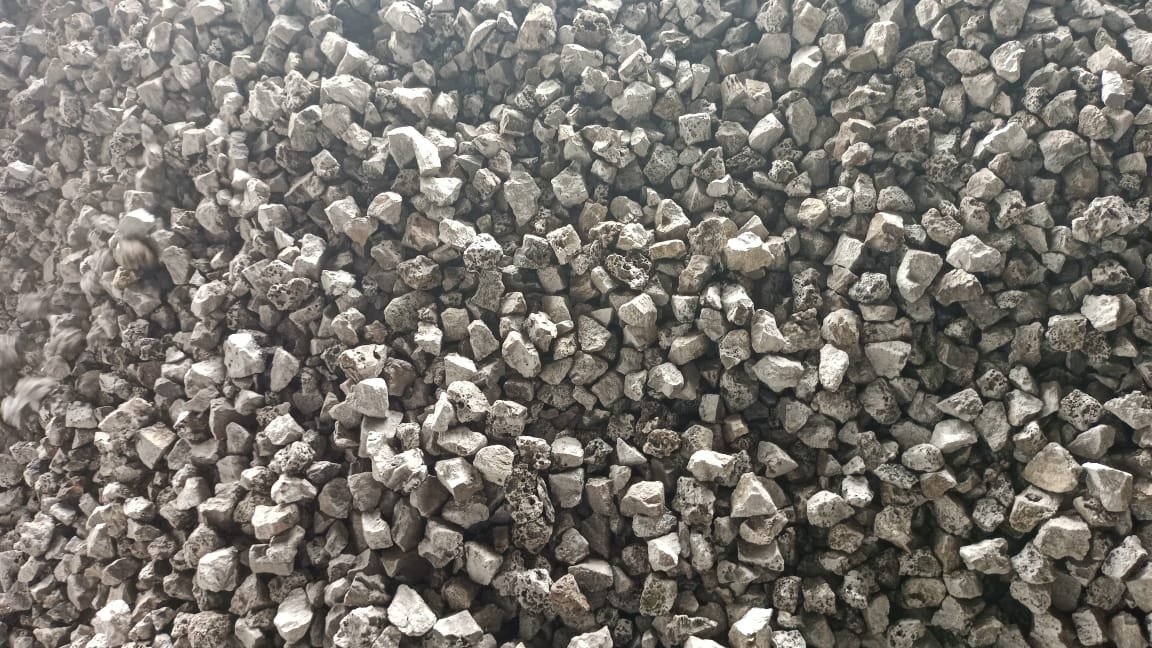
Ferro Chrome
Fe-Cr is an alloy comprised of iron and chromium. Besides chromium and iron, it also contains varying amounts of carbon and other elements such as silicon, sulphur, and phosphorus. It is used primarily in the production of stainless steel. The ratio in which the two metals (iron and chromium) are combined can vary, with the proportion of chromium ranging between 50 % and 70 %.
Fe-Cr is frequently classified by the ratio of chromium to carbon it contains. The vast majority of Fe-Cr produced globally is the ‘charge chrome’ (Ch-Cr). It has lower chromium to carbon ratio and is normally produced for use in stainless steel production. The Ch-Cr grade was introduced to differentiate it from the conventional high carbon Fe-Cr. The second largest produced Fe-Cr ferro-alloy is the high carbon Fe-Cr which has a higher content of chromium than the Ch-Cr grade and is being produced from higher grade of the chromite ore. Other grades of Fe-Cr are ‘medium carbon Fe-Cr and low carbon Fe-Cr. Medium carbon Fe-Cr is also known as intermediate carbon Fe-Cr and can contain upto 4 % of carbon. Lowe carbon Fe-Cr typically has the chromium content of 60 % minimum with carbon content ranging from 0.03 % to 0.15 %. However carbon content in low carbon Fe-Cr can go upto 1 %.
In international trade, Fe-Cr is classified primarily according to its carbon content. The common categories of Fe-Cr used in international trade are (i) Ch-Cr with a base of 52 % chromium, (ii) high carbon Fe-Cr with carbon content ranging from 6 % to 8 %, base of 60 % chromium, and a maximum of 1.5 % silicon, (iii) high carbon Fe-Cr with carbon content ranging from 6 % to 8 %, based on 60 % to 65 % chromium, and 2 % of silicon maximum, (iv) high carbon Fe-Cr with carbon content ranging from 6 % to 8 % and a base of 50 % of chromium, (v) high carbon Fe-Cr with low phosphorus having composition with chromium – 65 % minimum, carbon – 7 % maximum, silicon – 1 % maximum, phosphorus – 0.015 %, and titanium – 0.05 % maximum, (vi) Fe-Cr with carbon content from 0.10 % and chromium content in the range of 60 % to 70 %, (vii) low carbon Fe-Cr with 0.05 % of carbon and 65 % minimum of chromium, (viii) low carbon Fe-Cr with upto 0.06 % of carbon and 65 % of chromium, (ix) low carbon Fe-Cr with 0.10 % of carbon and 62 % minimum of chromium, (x) low carbon Fe-Cr with 0.10 % of carbon and 60 % to 70 % of chromium, and (xi) low carbon Fe-Cr with 0.15 % of carbon and 60 % minimum of chromium.
High carbon Fe-Cr and charge chrome are normally produced by the conventional smelting process utilizing carbo-thermic reduction of chromite ore (consisting oxides of chromite and iron) using a SAF or a DC (direct current) open arc electric furnace. The carbo-thermic reduction takes place at high temperatures. Chromite ore is reduced by coal and coke to form the Fe-Cr alloy. Ch-Cr is produced from a chrome containing ore with lower chrome content.
High carbon Fe-Cr produced from higher grade ore, is normally used in specialist applications such as engineering steels where a high chromium to iron ratio and minimum levels of other elements such as sulphur, phosphorus and titanium are important. Low carbon Fe – Cr is used during steel production to correct chrome percentages, without causing undesirable variations in the carbon or trace element percentages. It is also a low cost alternative to metallic chrome for uses in super alloys and other special melting applications.
Fe-Cr is frequently classified by the ratio of chromium to carbon it contains. The vast majority of Fe-Cr produced globally is the ‘charge chrome’ (Ch-Cr). It has lower chromium to carbon ratio and is normally produced for use in stainless steel production. The Ch-Cr grade was introduced to differentiate it from the conventional high carbon Fe-Cr. The second largest produced Fe-Cr ferro-alloy is the high carbon Fe-Cr which has a higher content of chromium than the Ch-Cr grade and is being produced from higher grade of the chromite ore. Other grades of Fe-Cr are ‘medium carbon Fe-Cr and low carbon Fe-Cr. Medium carbon Fe-Cr is also known as intermediate carbon Fe-Cr and can contain upto 4 % of carbon. Lowe carbon Fe-Cr typically has the chromium content of 60 % minimum with carbon content ranging from 0.03 % to 0.15 %. However carbon content in low carbon Fe-Cr can go upto 1 %.
In international trade, Fe-Cr is classified primarily according to its carbon content. The common categories of Fe-Cr used in international trade are (i) Ch-Cr with a base of 52 % chromium, (ii) high carbon Fe-Cr with carbon content ranging from 6 % to 8 %, base of 60 % chromium, and a maximum of 1.5 % silicon, (iii) high carbon Fe-Cr with carbon content ranging from 6 % to 8 %, based on 60 % to 65 % chromium, and 2 % of silicon maximum, (iv) high carbon Fe-Cr with carbon content ranging from 6 % to 8 % and a base of 50 % of chromium, (v) high carbon Fe-Cr with low phosphorus having composition with chromium – 65 % minimum, carbon – 7 % maximum, silicon – 1 % maximum, phosphorus – 0.015 %, and titanium – 0.05 % maximum, (vi) Fe-Cr with carbon content from 0.10 % and chromium content in the range of 60 % to 70 %, (vii) low carbon Fe-Cr with 0.05 % of carbon and 65 % minimum of chromium, (viii) low carbon Fe-Cr with upto 0.06 % of carbon and 65 % of chromium, (ix) low carbon Fe-Cr with 0.10 % of carbon and 62 % minimum of chromium, (x) low carbon Fe-Cr with 0.10 % of carbon and 60 % to 70 % of chromium, and (xi) low carbon Fe-Cr with 0.15 % of carbon and 60 % minimum of chromium.
High carbon Fe-Cr and charge chrome are normally produced by the conventional smelting process utilizing carbo-thermic reduction of chromite ore (consisting oxides of chromite and iron) using a SAF or a DC (direct current) open arc electric furnace. The carbo-thermic reduction takes place at high temperatures. Chromite ore is reduced by coal and coke to form the Fe-Cr alloy. Ch-Cr is produced from a chrome containing ore with lower chrome content.
High carbon Fe-Cr produced from higher grade ore, is normally used in specialist applications such as engineering steels where a high chromium to iron ratio and minimum levels of other elements such as sulphur, phosphorus and titanium are important. Low carbon Fe – Cr is used during steel production to correct chrome percentages, without causing undesirable variations in the carbon or trace element percentages. It is also a low cost alternative to metallic chrome for uses in super alloys and other special melting applications.
Lump Size 10-60 MM 90% Minimum
- ELEMENTS%
- Chromium %
- Carbon %
- Silicon %
- Sulphur %
- Phosphorus %
- HIGH CARBONGRADE
- 60 – 65
- 6 – 8
- 4 Maximum
- 0.05 Maximum
- 0.05 Maximum
- MEDIUM CARBONGRADE
- 60 Minimum
- 1.5 Maximum
- 0.1 Maximum
- 0.04 Maximum
- 0.03 Maximum
- LOW CARBONGRADE
- 70 - 75
- 0.1 Maximum
- 1.0 Maximum
- 0.02 Maximum
- 0.03 Maximum

